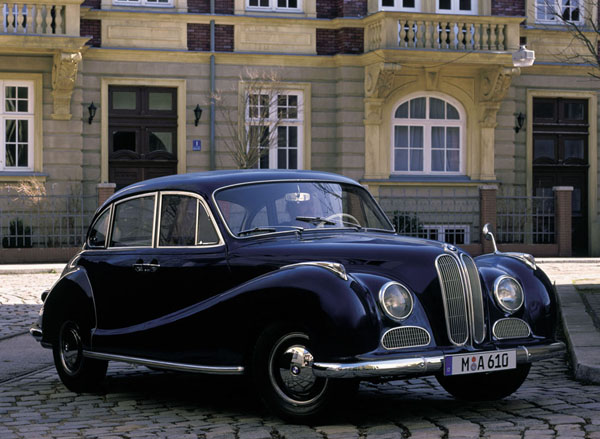
In July 1954 Germany’s first post-WWII car and BMW’s first V8 car – the 502 – was introduced. In using the same body as the 501, at first it was only recognisable from the outside by its extra chrome trim below the belt line, a V8 emblem on the boot lid and built-in foglights in its lower front guards. In late 1955 it got a wraparound rear window, but several months before this the 501 came out also with a V8 engine, no side chrome strips and a smaller rear window. After 1957 this latter model was simply called the BMW 2.6.
The V8 engine used in the 502 developed 75 kW, whereas the smaller one in the 501 only developed 71 kW, and was a front mounted water-cooled overhead valve engine using a single Solex carburettor driving the rear wheels through a four-speed gearbox. Initially the car came with drum brakes but in 1960 front wheel discs and rear wheel drums became standard.
Soft upholstery helped make the 502’s rear seat a pleasant place from which to be chauffeured. Full wheel covers were added later in the model’s life and whitewall tyres were offered as an option. The car featured the usual BMW bevel-gear steering system common in immediate postwar models. Front suspension was in the form of double A-arms with torsion bars and a live axle, also with torsion bars, was used for the rear suspension.
A total of 5955 of the model 502 were produced. This exceeded by 1310 units the number of model 501/3s produced. The 501, BMW’s first postwar passenger car, had an overhead valve six-cylinder engine which was a bored-out version of the two-litre engine based on the prewar 326, the extra 2 mm of bore raising capacity to 2077 cc.
Even the body of the 501/502 followed the general lines of the prewar 326 model without actually picking up where the 326 left off. On the 501, the six-cylinder engine with clutch was attached to the four-speed gearbox by a short shaft and the position of the gearbox under the front seats made its column shift linkage rather complicated.
Delivery of the first 501s to customers began more than a year after the model’s introduction. In addition to sedan versions, coupe and cabriolet versions of each 500 series model were produced. The 501 was succeeded by the 501A and 501B and in total 5328 units were produced.
In its original design phase BMW had considered using the Alfa Romeo 1900 body for the 501 but finally chose its own design. Despite this, the Alfa designer Pininfarina gave high praise to the graceful form of the new car when it was initially released.








